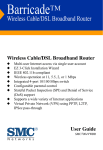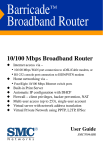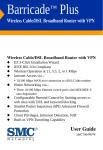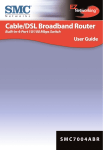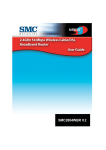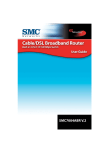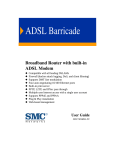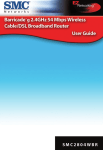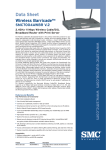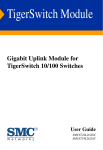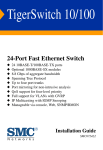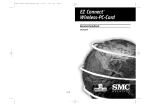Download SMC Networks Barricade SMC7004AWBR User's Manual
Transcript
Barricade™ Wireless Broadband Router Wireless Broadband Router ◆ Internet access via – • 10 Mbps WAN port connection to xDSL/Cable modem, or • RS-232 console port connection to ISDN/PSTN modem ◆ Home networking via – ◆ ◆ ◆ ◆ ◆ ◆ • Three 10/100 Mbps Ethernet switch ports, or • 11 Mbps wireless interface Built-in Print Server Automatic IP configuration with DHCP Firewall – client privileges, hacker prevention, NAT Multi-user access (up to 253), single-user account Virtual server with network address translation Virtual Private Network using PPTP, L2TP, IPSec User Guide SMC7004AWBR Barricade™ Wireless Broadband Router User Guide From SMC’s Barricade line of Broadband Routers 6 Hughes Irvine, CA 92618 Phone: (949) 707-2400 August 2001 Part Number: 01-111234-001 R02 Copyright Information furnished by SMC Networks, Inc. (SMC) is believed to be accurate and reliable. However, no responsibility is assumed by SMC for its use, nor for any infringements of patents or other rights of third parties which may result from its use. No license is granted by implication or otherwise under any patent or patent rights of SMC. SMC reserves the right to change specifications at any time without notice. Copyright © 2001 by SMC Networks, Inc. 6 Hughes Irvine, CA 92618 All rights reserved. Printed in Taiwan Trademarks: SMC is a registered trademark; and Barricade is a trademark of SMC Networks, Inc. Other product and company names are trademarks or registered trademarks of their respective holders. LIMITED WARRANTY Limited Warranty Statement: SMC Networks, Inc. (“SMC”) warrants its products to be free from defects in workmanship and materials, under normal use and service, for the applicable warranty term. All SMC products carry a standard 90-day limited warranty from the date of purchase from SMC or its Authorized Reseller. SMC may, at its own discretion, repair or replace any product not operating as warranted with a similar or functionally equivalent product, during the applicable warranty term. SMC will endeavor to repair or replace any product returned under warranty within 30 days of receipt of the product. The standard limited warranty can be upgraded to a Limited Lifetime* warranty by registering new products within 30 days of purchase from SMC or its Authorized Reseller. Registration can be accomplished via the enclosed product registration card or online via the SMC web site. Failure to register will not affect the standard limited warranty. The Limited Lifetime warranty covers a product during the Life of that Product, which is defined as the period of time during which the product is an “Active” SMC product. A product is considered to be “Active” while it is listed on the current SMC price list. As new technologies emerge, older technologies become obsolete and SMC will, at its discretion, replace an older product in its product line with one that incorporates these newer technologies. At that point, the obsolete product is discontinued and is no longer an “Active” SMC product. A list of discontinued products with their respective dates of discontinuance can be found at: http://www.smc.com/smc/pages_html/support.html All products that are replaced become the property of SMC. Replacement products may be either new or reconditioned. Any replaced or repaired product carries either a 30-day limited warranty or the remainder of the initial warranty, whichever is longer. SMC is not responsible for any custom software or firmware, configuration information, or memory data of Customer contained in, stored on, or integrated with any products returned to SMC pursuant to any warranty. Products returned to SMC should have any customer-installed accessory or add-on components, such as expansion modules, removed prior to returning the product for replacement. SMC is not responsible for these items if they are returned with the product. Customers must contact SMC for a Return Material Authorization number prior to returning any product to SMC. Proof of purchase may be required. Any product returned to SMC without a valid Return Material Authorization (RMA) number clearly marked on the outside of the package will be returned to customer at customer's expense. For warranty claims within North America, please call our toll-free customer support number at (800) 762-4968. Customers are responsible for all shipping charges from their facility to SMC. SMC is responsible for return shipping charges from SMC to customer. v LIMITED WARRANTY WARRANTIES EXCLUSIVE: IF AN SMC PRODUCT DOES NOT OPERATE AS WARRANTED ABOVE, CUSTOMER’S SOLE REMEDY SHALL BE REPAIR OR REPLACEMENT OF THE PRODUCT IN QUESTION, AT SMC’S OPTION. THE FOREGOING WARRANTIES AND REMEDIES ARE EXCLUSIVE AND ARE IN LIEU OF ALL OTHER WARRANTIES OR CONDITIONS, EXPRESS OR IMPLIED, EITHER IN FACT OR BY OPERATION OF LAW, STATUTORY OR OTHERWISE, INCLUDING WARRANTIES OR CONDITIONS OF MERCHANTABILITY AND FITNESS FOR A PARTICULAR PURPOSE. SMC NEITHER ASSUMES NOR AUTHORIZES ANY OTHER PERSON TO ASSUME FOR IT ANY OTHER LIABILITY IN CONNECTION WITH THE SALE, INSTALLATION, MAINTENANCE OR USE OF ITS PRODUCTS. SMC SHALL NOT BE LIABLE UNDER THIS WARRANTY IF ITS TESTING AND EXAMINATION DISCLOSE THE ALLEGED DEFECT IN THE PRODUCT DOES NOT EXIST OR WAS CAUSED BY CUSTOMER'S OR ANY THIRD PERSON'S MISUSE, NEGLECT, IMPROPER INSTALLATION OR TESTING, UNAUTHORIZED ATTEMPTS TO REPAIR, OR ANY OTHER CAUSE BEYOND THE RANGE OF THE INTENDED USE, OR BY ACCIDENT, FIRE, LIGHTNING, OR OTHER HAZARD. LIMITATION OF LIABILITY: IN NO EVENT, WHETHER BASED IN CONTRACT OR TORT (INCLUDING NEGLIGENCE), SHALL SMC BE LIABLE FOR INCIDENTAL, CONSEQUENTIAL, INDIRECT, SPECIAL, OR PUNITIVE DAMAGES OF ANY KIND, OR FOR LOSS OF REVENUE, LOSS OF BUSINESS, OR OTHER FINANCIAL LOSS ARISING OUT OF OR IN CONNECTION WITH THE SALE, INSTALLATION, MAINTENANCE, USE, PERFORMANCE, FAILURE, OR INTERRUPTION OF ITS PRODUCTS, EVEN IF SMC OR ITS AUTHORIZED RESELLER HAS BEEN ADVISED OF THE POSSIBILITY OF SUCH DAMAGES. SOME STATES DO NOT ALLOW THE EXCLUSION OF IMPLIED WARRANTIES OR THE LIMITATION OF INCIDENTAL OR CONSEQUENTIAL DAMAGES FOR CONSUMER PRODUCTS, SO THE ABOVE LIMITATIONS AND EXCLUSIONS MAY NOT APPLY TO YOU. THIS WARRANTY GIVES YOU SPECIFIC LEGAL RIGHTS, WHICH MAY VARY FROM STATE TO STATE. NOTHING IN THIS WARRANTY SHALL BE TAKEN TO AFFECT YOUR STATUTORY RIGHTS. * SMC will provide warranty service for one year following discontinuance from the active SMC price list. Under the limited lifetime warranty, internal and external power supplies, fans, and cables are covered by a standard one-year warranty from date of purchase. SMC Networks, Inc. 6 Hughes Irvine, CA 92618 vi COMPLIANCES FCC - Class B This equipment has been tested and found to comply with the limits for a Class B digital device, pursuant to Part 15 of the FCC Rules. These limits are designed to provide reasonable protection against harmful interference in a residential installation. This equipment generates, uses and can radiate radio frequency energy and, if not installed and used in accordance with instructions, may cause harmful interference to radio communications. However, there is no guarantee that the interference will not occur in a particular installation. If this equipment does cause harmful interference to radio or television reception, which can be determined by turning the equipment off and on, the user is encouraged to try to correct the interference by one or more of the following measures: • Reorient the receiving antenna • Increase the separation between the equipment and receiver • Connect the equipment into an outlet on a circuit different from that to which the receiver is connected • Consult the dealer or an experienced radio/TV technician for help EC Conformance Declaration - Class B SMC contact for these products in Europe is: SMC Networks Europe, Edificio Conata II, Calle Fructuós Gelabert 6-8, 2o, 4a, 08970 - Sant Joan Despí, Barcelona, Spain. This information technology equipment complies with the requirements of the Council Directive 89/336/EEC on the Approximation of the laws of the Member States relating to Electromagnetic Compatibility and 73/23/EEC for electrical equipment used within certain voltage limits and the Amendment Directive 93/68/ EEC. For the evaluation of the compliance with these Directives, the following standards were applied: RFI Emission: * Limit class B according to EN 55022:1998 * Limit class A for harmonic current emission according to EN 61000-3-2/ 1995 * Limitation of voltage fluctuation and flicker in low-voltage supply system according to EN 61000-3-3/1995 Immunity: * Product family standard according to EN 55024:1998 vii LVD: * Electrostatic Discharge according to EN 61000-4-2:1995 (Contact Discharge: ±4 kV, Air Discharge: ±8 kV) * Radio-frequency electromagnetic field according to EN 61000-4-3: 1996 (80 - 1000MHz with 1kHz AM 80% Modulation: 3V/m) * Electrical fast transient/burst according to EN 61000-4-4:1995(AC/DC power supply: ±1kV, Data/Signal lines: ±0.5kV) * Surge immunity test according to EN 61000-4-5:1995 (AC/DC Line to Line: ±1kV, AC/DC Line to Earth: ±2kV ) * Immunity to conducted disturbances, Induced by radio-frequency fields: EN 61000-4-6:1996 (0.15 - 80MHz with 1kHz AM 80% Modulation: 3V/m) * Power frequency magnetic field immunity test according to EN 61000-4-8:1993 (1A/m at frequency 50Hz) * Voltage dips, short interruptions and voltage variations immunity test according to EN 61000-4-11:1994 (>95% Reduction @10ms, 30% Reduction @500ms, >95% Reduction @5000ms) * EN 60950 (A1/1992; A2/1993; A3/1993; A4/1995; A11/1997) Industry Canada - Class B This digital apparatus does not exceed the Class B limits for radio noise emissions from digital apparatus as set out in the interference-causing equipment standard entitled “Digital Apparatus,” ICES-003 of the Department of Communications. Cet appareil numérique respecte les limites de bruits radioélectriques applicables aux appareils numériques de Classe B prescrites dans la norme sur le matériel brouilleur: “Appareils Numériques,” NMB-003 édictée par le ministère des Communications. Japan VCCI Class B Australia AS/NZS 3548 (1995) - Class B SMC contact for products in Australia is: SMC Communications Pty. Ltd. Suite 18, 12 Tryon Road, Lindfield NSW2070, Phone: 61-2-94160437 Fax: 61-2-94160474 viii LIMITED WARRANTY Safety Compliance Underwriters Laboratories Compliance Statement Important! Before making connections, make sure you have the correct cord set. Check it (read the label on the cable) against the following: Operating Voltage 120 Volts Cord Set Specifications UL Listed/CSA Certified Cord Set Minimum 18 AWG Type SVT or SJT three conductor cord Maximum length of 15 feet Parallel blade, grounding type attachment plug rated 15A, 125V 240 Volts (Europe only) Cord Set with H05VV-F cord having three conductors with minimum diameter of 0.75 mm2 IEC-320 receptacle Male plug rated 10A, 250V The unit automatically matches the connected input voltage. Therefore, no additional adjustments are necessary when connecting it to any input voltage within the range marked on the rear panel. Wichtige Sicherheitshinweise (Germany) 1. Bitte lesen Sie diese Hinweise sorgfältig durch. 2. Heben Sie diese Anleitung für den späteren Gebrauch auf. 3. Vor jedem Reinigen ist das Gerät vom Stromnetz zu trennen. Verwenden Sie keine Flüssigoder Aerosolreiniger. Am besten eignet sich ein angefeuchtetes Tuch zur Reinigung. 4. Die Netzanschlu ßsteckdose soll nahe dem Gerät angebracht und leicht zugänglich sein. 5. Das Gerät ist vor Feuchtigkeit zu schützen. 6. Bei der Aufstellung des Gerätes ist auf sicheren Stand zu achten. Ein Kippen oder Fallen könnte Beschädigungen hervorrufen. 7. Die Belüftungsöffnungen dienen der Luftzirkulation, die das Gerät vor Überhitzung schützt. Sorgen Sie dafür, daß diese Öffnungen nicht abgedeckt werden. 8. Beachten Sie beim Anschluß an das Stromnetz die Anschlußwerte. 9. Verlegen Sie die Netzanschlußleitung so, daß niemand darüber fallen kann. Es sollte auch nichts auf der Leitung abgestellt werden. 10. Alle Hinweise und Warnungen, die sich am Gerät befinden, sind zu beachten. COMPLIANCES 11. Wird das Gerät über einen längeren Zeitraum nicht benutzt, sollten Sie es vom Stromnetz trennen. Somit wird im Falle einer Überspannung eine Beschädigung vermieden. 12. Durch die Lüftungsöffnungen dürfen niemals Gegenstände oder Flüssigkeiten in das Gerät gelangen. Dies könnte einen Brand bzw. elektrischen Schlag auslösen. 13. Öffnen sie niemals das Gerät. Das Gerät darf aus Gründen der elektrischen Sicherheit nur von authorisiertem Servicepersonal geöffnet werden. 14. Wenn folgende Situationen auftreten ist das Gerät vom Stromnetz zu trennen und von einer qualifizierten Servicestelle zu überprüfen: a. b. c. d. Netzkabel oder Netzstecker sind beschädigt. Flüssigkeit ist in das Gerät eingedrungen. Das Gerät war Feuchtigkeit ausgesetzt. Wenn das Gerät nicht der Bedienungsanleitung entsprechend funktioniert oder Sie mit Hilfe dieser Anleitung keine Verbesserung erzielen. e. Das Gerät ist gefallen und/oder das Gehäuse ist beschädigt. f. Wenn das Gerät deutliche Anzeichen eines Defektes aufweist. 15. Stellen Sie sicher, daß die Stromversorgung dieses Gerätes nach der EN 60950 geprüft ist. Ausgangswerte der Stromversorgung sollten die Werte von AC 7,5-8V, 50-60Hz nicht über oder unterschreiten sowie den minimalen Strom von 1A nicht unterschreiten. Der arbeitsplatzbezogene Schalldruckpegel nach DIN 45 635 Teil 1000 beträgt 70dB(A) oder weniger. x TABLE 1 OF CONTENTS Introduction . . . . . . . . . . . . . . . . . . . . . . . . . . . . 1-1 About the Wireless Barricade . . . . . . . . . . . . . . . . . . . . . . . . . 1-1 Features and Benefits . . . . . . . . . . . . . . . . . . . . . . . . . . . . . . . 1-2 Applications . . . . . . . . . . . . . . . . . . . . . . . . . . . . . . . . . . . . . 1-3 2 Installation . . . . . . . . . . . . . . . . . . . . . . . . . . . . . . 2-1 Package Contents . . . . . . . . . . . . . . . . . . . . . . . . . . . . . . . Description of Hardware . . . . . . . . . . . . . . . . . . . . . . . . . . System Requirements . . . . . . . . . . . . . . . . . . . . . . . . . . . . . Connect the System . . . . . . . . . . . . . . . . . . . . . . . . . . . . . . Basic Installation Procedure . . . . . . . . . . . . . . . . . . . Attach to Your Network Using Ethernet Cabling . Attach to Your Network Using Radio Signals . . . . Attach the Wireless Barricade to the Internet . . . . Connect the Wireless Barricade to a Printer . . . . . Connecting the Power Adapter . . . . . . . . . . . . . . Verify Port Status . . . . . . . . . . . . . . . . . . . . . . . . . . . 3 . . 2-1 . . 2-2 . . 2-5 . . 2-6 . . 2-6 . . 2-7 . . 2-8 . 2-10 . 2-10 . 2-11 . 2-11 Configuring Client PCs . . . . . . . . . . . . . . . . . . . . 3-1 TCP/IP Configuration . . . . . . . . . . . . . . . . . . . . . . . . . . . . . . . 3-1 Printer Client Installation . . . . . . . . . . . . . . . . . . . . . . . . . . . . 3-2 4 Configuring the Barricade . . . . . . . . . . . . . . . . . 4-1 Navigating the Web Browser Interface . . . Setting a Password . . . . . . . . . . . . . Making Configuration Changes . . . . Main Menu . . . . . . . . . . . . . . . . . . . . . . . Networking and Client Services . . . . . . . . Change Password . . . . . . . . . . . . . . Set Time Zone . . . . . . . . . . . . . . . . LAN Gateway and DHCP Settings . . WAN Configuration . . . . . . . . . . . . Dynamic IP Address – DHCP . . Static IP Address – Fixed IP . . . PPP over Ethernet – PPPoE . . . . Dial-up on Demand – Modem . ... ... ... ... ... ... ... ... ... ... ... ... ... .... .... .... .... .... .... .... .... .... .... .... .... .... .. .. .. .. .. .. .. .. .. .. .. .. .. . . . . . . . . . . . . . . . . . . . . . . . . . . . . . . . . . . . . . . . . . . . . . . . . . . . . . . 4-2 . . 4-2 . . 4-2 . . 4-3 . . 4-5 . . 4-6 . . 4-7 . . 4-7 . . 4-8 . . 4-9 . . 4-9 . 4-10 . 4-11 xi TABLE OF CONTENTS DNS Configuration . . . . . . . . . . . Wireless Configuration . . . . . . . . . Channel and SSID . . . . . . . . . Encryption . . . . . . . . . . . . . . Configuring Client Services . . . . . Firewall Protection . . . . . . . . Virtual Server . . . . . . . . . . . . Enabling Special Applications Client Filtering . . . . . . . . . . . MAC Filtering . . . . . . . . . . . . Miscellaneous Settings – Misc Viewing Network and Device Status . . . Using System Tools . . . . . . . . . . . . . . . . 5 ... ... ... ... ... ... ... ... ... ... ... ... ... ... ... ... ... ... ... ... ... ... ... ... ... ... . . . . . . . . . . . . . . . .. .. .. .. .. .. .. .. .. .. .. .. .. 4-12 4-13 4-13 4-14 4-16 4-16 4-17 4-18 4-19 4-20 4-23 4-25 4-26 . . . . . . . . . . . . . . . . . . . . . . . . . . . . . . . . . . . 5-1 5-3 5-4 5-5 5-6 Configuring Printer Services . . . . . . . . . . . . . . . . 6-1 Install the Printer Port Monitor . . . . . . . . . . . . . . . . Configure the Print Server . . . . . . . . . . . . . . . . . . . . Configure the Network Printer in Windows 95/98/ME/2000 . . . . . . . . . . . Configure the Network Printer in Windows NT Configure the Network Printer in Unix Systems xii ... ... ... ... ... ... ... ... ... ... ... ... ... Configuring Client TCP/IP . . . . . . . . . . . . . . . . . . 5-1 Installing TCP/IP Protocol in Your PC . . . . . . . . Setting TCP/IP to Work with the Barricade . . . . Dynamic IP Allocation via a DHCP Server Manual IP Configuration . . . . . . . . . . . . . Verifying Your TCP/IP Connection . . . . . . 6 .... .... .... .... .... .... .... .... .... .... .... .... .... . . . . . . . 6-1 . . . . . . . 6-4 . . . . . . . 6-4 . . . . . . . 6-6 . . . . . . 6-8 TABLE OF CONTENTS APPENDICES: A Troubleshooting . . . . . . . . . . . . . . . . . . . . . . . . . .A-1 B Cables . . . . . . . . . . . . . . . . . . . . . . . . . . . . . . . . . .B-1 Ethernet Cable . . . . . . . . . . . . . . . . . . . . . . . . . Specifications . . . . . . . . . . . . . . . . . . . . . Twisted-pair Cable . . . . . . . . . . . . . . . . . Straight-through Cable . . . . . . . . . . . . Crossover Cable . . . . . . . . . . . . . . . . RJ-45 Port Pin Assignments . . . . . . . . . . . . . . . . Serial Port Pin Assignments . . . . . . . . . . . . . . . . DB-9 Port Pin Assignments . . . . . . . . . . . Serial Port to 9-Pin COM Port on PC . . . . . Serial Port to 25-Pin DCE Port on Modem . Serial Port to 25-Pin DTE Port on PC . . . . Printer Port Pin Assignments . . . . . . . . . . . . . . . DB-25 Printer Port Pin Assignments . . . . . .... .... .... .... .... .... .... .... .... .... .... .... .... ... ... ... ... ... ... ... ... ... ... ... ... ... ... ... ... ... ... ... ... ... ... ... ... ... ... B-1 B-1 B-1 B-2 B-2 B-3 B-4 B-4 B-5 B-5 B-5 B-6 B-6 C Specifications . . . . . . . . . . . . . . . . . . . . . . . . . . . .C-1 D Ordering Information . . . . . . . . . . . . . . . . . . . . D-1 xiii TABLE OF CONTENTS xiv CHAPTER 1 INTRODUCTION Congratulations on your purchase of the Barricade™ Wireless Broadband Router. SMC is proud to provide you with a powerful yet simple communication device for connecting your local area network (wired or wireless LAN) to the Internet. For those who want to surf the Internet at the lowest possible cost, this Broadband Router provides a convenient and powerful solution. About the Wireless Barricade The Wireless Barricade provides Internet access to multiple users by sharing a single-user account. It serves as a wireless Access Point, and includes a dual-port WAN interface which allows you to connect to an xDSL or Cable modem, ISDN TA or PSTN analog modem. The Wireless Barricade provides extensive firewall protection and Virtual Private Network (VPN) services. It also provides print services for any client attached to a LAN port. The Wireless Barricade supports dial-on-demand for ISDN/PSTN service, automatically connecting to the Internet when there are requests and terminating the connection if no further requests occur. This dual-port design also supports fail-over Internet access through the secondary WAN port (i.e., the serial port can be used for primary or backup Internet access). This new Wireless Barricade technology provides many cost-effective functions and management benefits. It is simple to configure and can be up and running in minutes. 1-1 FEATURES AND BENEFITS Features and Benefits 1-2 • Internet connection to xDSL or Cable modem via a 10 Mbps WAN port • Internet connection to ISDN TA or PSTN modem via an RS-232 console port • Local network connection via 10/100 Mbps Ethernet ports or 11 Mbps wireless interface (supporting up to 128 mobile users) • 802.11b Compliant – interoperable with multiple vendors • Provides seamless roaming within 802.11b WLAN environment • Supports 64-bit and 128-bit WEP (Wired Equivalent Privacy) • Built-in Print Server for any client attached to the LAN • DHCP for dynamic IP configuration, and DNS for domain name mapping • Firewall with client privileges, hacker prevention, and NAT • NAT also enables multi-user access with a single-user account, and virtual server functionality (providing protected access to Internet services such as Web, FTP, mail and Telnet) • Virtual Private Network support using PPTP, L2TP or IPSec pass-through • User-definable application sensing tunnel supports applications requiring multiple connections • Supports CHAP authentication protocol for dial-up identification INTRODUCTION • Supports PPP dial-in connection using standard dial-up program • Easy setup through a Web browser on any operating system that supports TCP/IP • Compatible with all popular Internet applications Applications Many advanced applications are provided by the Wireless Barricade, such as: • Flexible LAN Access The Wireless Barricade provides connectivity to 10/100 Mbps wired devices as well as 11 Mbps wireless mobile users. The wireless interface makes it easy to create a network in difficult-to-wire environments, or to provide quick access to databases for mobile workers. • Internet Access This device supports Internet access through an xDSL, Cable, ISDN or PSTN connection. Since many DSL providers use PPPoE to establish communications with end users, the Wireless Barricade includes a built-in client for this protocol, eliminating the need to install this service on your computer. • Shared IP Address The Wireless Barricade provides Internet access for up to 253 users with a shared IP address. Using only one ISP account, multiple users on your network can browse the Web at the same time. 1-3 APPLICATIONS • Virtual Server If you have a fixed IP address, you can set up the Wireless Barricade to act as a virtual host for network address translation. Remote users access various services at your site using a constant IP address. Then, depending on the requested service (or port number), the Wireless Barricade can route the request to the appropriate server (at another internal IP address). This secures your network from direct attack by hackers, and provides more flexible management by allowing you to change internal IP addresses without affecting outside access to your network. • User-Definable Application Sensing Tunnel You can define special applications that require multiple connections such as Internet gaming, videoconferencing, and Internet telephony. The Wireless Barricade can then sense the application type and open a multi-port tunnel for it. • DMZ Host Support Allows a networked computer to be fully exposed to the Internet. This function is used when the special application sensing tunnel feature is insufficient to allow an application to function correctly. • Security The Wireless Barricade supports security features that can deny Internet access to specified users, or filter all requests for specific services the administrator does not want to serve. The Wireless Barricade’s firewall can also block common hacker attacks, including IP Spoofing, Land Attack, Ping of Death, IP with zero length, Smurf Attack, UDP port loopback, Snork Attack, TCP null scan, and TCP SYN flooding. 1-4 INTRODUCTION • Virtual Private Network The Wireless Barricade supports three of the most commonly used VPN protocols – PPTP, L2TP and IPSec. These protocols allow remote users to establish a secure connection to their corporate network. If your service provider supports VPNs, then any of these protocols can be used to create an authenticated and encrypted tunnel for passing secure data over the Internet (i.e., a traditionally shared data network). The VPN protocols supported by the Wireless Barricade are briefly described below. • Point-to-Point Tunneling Protocol – Provides a secure tunnel for remote client access to a PPTP security gateway. PPTP includes provisions for call origination and flow control required by ISPs. • Layer Two Tunneling Protocol – Includes most of the features provided by PPTP, but has less overhead and is more suited for managed networks. • IP Security – Provides IP network-layer encryption. IPSec can support large encryption networks (such as the Internet) by using digital certificates for device authentication. 1-5 APPLICATIONS 1-6 CHAPTER 2 INSTALLATION Before installing the Barricade™ Wireless Broadband Router, verify that you have all the items listed under “Package Contents.” If any of the items are missing or damaged, contact your local SMC distributor. Also be sure that you have all the necessary cabling before installing the Wireless Barricade. After installing the Wireless Barricade, refer to the Web-based configuration program in Chapter 4 for information on configuring the router. Package Contents After unpacking the Barricade Wireless Broadband Router, check the contents of the box to be sure you’ve received the following components: • Barricade 4-port Wireless Broadband Router • Power adapter (5V, 2.4A) • One CAT-5 Ethernet cable • Four rubber feet • Installation CD with complete user guide • Quick Installation Guide • SMC Warranty Registration Card Immediately inform your dealer in the event of any incorrect, missing or damaged parts. If possible, please retain the carton and original packing materials in case there is a need to return the product. 2-1 INSTALLATION Please fill out and return the Warranty Registration Card to SMC or register on SMC’s Web site at www.smc.com. The Barricade Wireless Broadband Router is covered by a limited lifetime warranty. Description of Hardware The Barricade Wireless Broadband Router can be connected to the Internet or to a remote site using its RJ-45 WAN port or RS-232 serial port. It can be connected directly to your PC or to a local area network using any of the three Fast Ethernet LAN ports or through the wireless interface. It can also function as a print server. Access speed to the Internet depends on your service type. Full-rate ADSL can provide up to 8 Mbps downstream and 640 Mbps upstream. G.lite (or splitterless) ADSL provides up to 1.5 Mbps downstream and 512 Kbps upstream. Cable modems can provide up to 36 Mbps downstream and 2 Mbps upstream. ISDN can provide up to 128 Kbps when using two bearer channels. And PSTN analog connections can now run up to 56 Kbps. However, you should note that the actual rate provided by specific service providers may vary dramatically from these upper limits. Although access speed to the Internet is determined by the modem type connected to your Wireless Barricade, data passing between devices connected to your local area network can run up to 100 Mbps over the Fast Ethernet ports. The Wireless Barricade includes an LED display on the front panel for system power and port indications that simplifies installation and network troubleshooting. It also provides three RJ-45 LAN ports, one RJ-45 WAN port, one RS-232 serial port, one parallel printer port, as well as two antennas on the rear panel. 2-2 INSTALLATION • Three RJ-45 ports for connection to a 10BASE-T/100BASE-TX Ethernet Local Area Network (LAN). These ports can autonegotiate the operating speed to 10/100 Mbps, the mode to half/full duplex, and the pin signals to MDI/MDI-X (i.e., allowing these ports to be connected to any network device with straight-through cable). These ports can be connected directly to a PC or to a server equipped with an Ethernet network interface card, or to a networking device such as an Ethernet hub or switch. • One RJ-45 port for connection to an xDSL or Cable modem. This port is fixed at 10 Mbps, full duplex. Use a Category 5 cable to connect this WAN port to a xDSL or Cable modem. • One RS-232 serial port to connect to an ISDN Terminal Adapter (TA) or to a PSTN analog modem. • One parallel printer port that can be connected to a printer. This printer can then be shared by any LAN/WLAN users. • Two antennas (dipole, omni-directional). 2-3 INSTALLATION The following figure shows the components of the Wireless Barricade: PWR WLAN WAN LAN 1 2 3 Link SMC7004AWBR Activity RESET PRINTER COM WAN 1 2 3 5V 2A MAX Figure 2-1. Front and Rear Panels Item Description LEDs Power, WLAN, WAN and LAN port status indicators. (See Verify Port Status on page 2-11.) Wireless Dual antennas provide optimal reception by dynamically Antennas choosing the best antenna for each client. 2-4 Reset Button Use this button to reset the power and restore the default factory settings. Printer Port Parallel port (25-pins, D-type, female). Connect the shared printer to this port. COM Port Serial port (9-pins, D-type, male). Connect your ISDN TA or 56K analog modem to this port. WAN Port WAN port (RJ-45). Connect your Cable modem, xDSL modem, or an Ethernet router to this port. LAN Ports Fast Ethernet ports (RJ-45). Connect devices on your local area network to these ports (such as a PC, hub or switch). INSTALLATION Item Description Power Inlet Connect the included power adapter to this inlet. Warning: The included power adapter is DC 5V/2A. Using the wrong type of power adapter may cause damage. System Requirements You must have an Internet Service Provider (ISP) that meets the following minimum requirements: • Internet access from your local telephone company or ISP using an xDSL modem, Cable modem, ISDN TA, or PSTN analog modem. You may also have access over the telephone system to an analog modem at another site. • A PC using a fixed IP address or dynamic IP address assignment via DHCP, as well as a Gateway server address and DNS server address from your service provider. • For wired LAN connection, you need a computer equipped with a 10 Mbps, 100 Mbps, or 10/100 Mbps Fast Ethernet card, or a USB-to-Ethernet converter. For wireless LAN connections, each computer must have an 11 Mbps wireless adapter. • TCP/IP network protocol installed on each PC that needs to access the Internet. • A Java-enabled Web browser, such as Microsoft Internet Explorer 5.0 or above or Netscape Communicator 4.0 or above installed on one PC at your site for configuring the Wireless Barricade. 2-5 INSTALLATION Connect the System The Wireless Barricade can be positioned at any convenient location in your office or home. No special wiring or cooling requirements are needed. You should, however comply with the following guidelines: • Keep the Wireless Barricade away from any heating devices. • Do not place the Wireless Barricade in a dusty or wet environment. You should also remember to turn off the power, remove the power cord from the outlet, and keep your hands dry when you install the Wireless Barricade. Basic Installation Procedure 1. Connect the LAN: You can connect the Wireless Barricade to your PC, or to a hub or switch. Run Ethernet cable from one of the LAN ports on the rear of the Wireless Barricade to your computer’s network adapter or to another network device. You can also connect the Wireless Barricade to your PC (using a wireless client adapter) via radio signals. Position both antennas on the back of the Wireless Barricade into the desired positions. For more effective coverage, you may want to position one antenna along the vertical axis and the other antenna along the horizontal axis. (The antennas emit signals along the toroidal plane – and thus provide more effective coverage when positioned along alternate axes.) 2. Connect the WAN: Prepare an Ethernet cable for connecting the Wireless Barricade to a Cable/xDSL modem or Ethernet router. Prepare a serial cable for connecting the Wireless Barricade to an ISDN TA or PSTN modem. 2-6 INSTALLATION 3. Connect your printer: Use standard parallel printer cable to connect your printer to the printer port on the Wireless Barricade. 4. Power on: Connect the power adapter to the Wireless Barricade. Internet Internet Access Device SMC7004AWBR Wireless Broadband Router LAN PWR SMC700 WLAN WAN 1 2 3 Link Activity 4AWBR Notebook with Wireless PC Card SOHO Office or Residence Figure 2-2. Connecting the Wireless Barricade Attach to Your Network Using Ethernet Cabling The three LAN ports on the Wireless Barricade can auto-negotiate the connection speed to 10 Mbps Ethernet or 100 Mbps Fast Ethernet, as well as the transmission mode to half-duplex or full-duplex. These LAN ports also support auto-configuration for pin signals (auto-MDI/MDI-X) that allows you to use straight-through cable for connecting the Wireless Barricade to any network device. (See Appendix B for details on wiring.) Use twisted-pair cable to connect any of the three LAN ports on the Wireless Barricade to an Ethernet adapter on your PC. Otherwise, you can cascade any of LAN ports on the Wireless Barricade to an Ethernet hub or switch, and then connect your PC or other network equipment to the hub or switch. When inserting an RJ-45 plug, be sure the tab on the plug clicks into position to ensure that it is properly seated. 2-7 INSTALLATION Warning: Do not plug a phone jack connector into any RJ-45 port. This may damage the Wireless Barricade. Instead, use only twisted-pair cables with RJ-45 connectors that conform with FCC standards. Notes: 1. Use 100-ohm shielded or unshielded twisted-pair cable with RJ-45 connectors for all connections. Use Category 3, 4 or 5 for connections that operate at 10 Mbps, and Category 5 for connections that operate at 100 Mbps. 2. Make sure each twisted-pair cable does not exceed 100 meters (328 feet). RESET PRINTER COM WAN 1 2 3 5V 2A MAX Figure 2-3. Making LAN Connections Attach to Your Network Using Radio Signals Install a wireless network adapter in each computer that will be connected to the Internet or your local network via radio signals. SMC currently offers several wireless network cards, including the SMC2602W Wireless PCI card and the SMC2632W Wireless PC card. Rotate both antennas on the back of the Wireless Barricade to the desired position. For more effective coverage, position one antenna along the vertical axis and the other along the horizontal axis. Try to place the Wireless Barricade in a position that is located in the center of your wireless network. Normally, the higher you place the antenna, the better the performance. Ensure that the Wireless Barricade’s location provides optimal reception throughout your home or office. 2-8 INSTALLATION Computers equipped with a wireless adapter can communicate with each other as an independent wireless LAN by configuring each computer to the same radio channel. However, the Wireless Barricade can provide access to your wired/wireless LAN or to the Internet for all wireless workstations. Each wireless PC in this network infrastructure can talk to any computer in the wireless group via a radio link, or access other computers or network resources in the wired LAN infrastructure or over the Internet via the Wireless Barricade. The wireless infrastructure configuration not only extends the accessibility of wireless PCs to the wired LAN, but also doubles the effective wireless transmission range for wireless PCs by retransmitting incoming radio signals through the Wireless Barricade. A wireless infrastructure can be used for access to a central database, or for connection between mobile workers, as shown in the following figure: Wired to Wireless Network Extension Internet Internet Access Device Notebook with Wireless PC Card Adapter LAN 1 2 3 SMC7004AWBR Wireless Broadband Router PWR SMC7004 WLAN WAN Link Activity AWBR Wired LAN PC with Wireless PCI Adapter Figure 2-4. Making WLAN Connections 2-9 INSTALLATION Attach the Wireless Barricade to the Internet If Internet services are provided through an xDSL or Cable modem, use unshielded or shielded twisted-pair Ethernet cable (Category 3 or greater) with RJ-45 plugs to connect the broadband modem directly to the WAN port on the Wireless Barricade. Use either straight-through or crossover cable depending on the port type provided by the modem (see Appendix B). For ISDN or PSTN service, attach the access device to the RS-232 serial port on the Wireless Barricade. RESET PRINTER COM WAN 1 2 3 ISDN TA/ PSTN Modem ISP (Primary or Backup) 5V 2A MAX DSL/Cable Modem ISP (Primary) Figure 2-5. Making WAN Connections Note: When connecting to the WAN port, use 100-ohm Category 3, 4 or 5 shielded or unshielded twisted-pair cable with RJ-45 connectors at both ends for all connections. Connect the Wireless Barricade to a Printer If you connect a printer to the Wireless Barricade, all the computer users connected to your LAN can have access to the printer. Connect a standard parallel printer cable to the Printer port on the Wireless Barricade, and configure the printer server as described on page 6-1. 2-10 INSTALLATION Connecting the Power Adapter Plug the power adapter into the power socket on the Wireless Barricade, and the other end into a power outlet. Check the indicator marked Power on the front panel to be sure it is on. If the Power indicator does not light up, refer to Troubleshooting in Appendix A. Verify Port Status Check the power and port indicators as shown in the following table. LED Condition Status Power (Green) On Wireless Barricade is receiving power. WLAN (Green) On The Wireless Barricade has established a valid wireless connection. WAN (Green) On The WAN port has established a valid network connection. Link (Green) On The indicated LAN port has established a valid network connection. Activity (Amber) Flashing The indicated LAN port is transmitting or receiving traffic. LAN 2-11 INSTALLATION 2-12 CONFIGURING CHAPTER 3 CLIENT PCS TCP/IP Configuration To access the Internet through the Barricade™ Wireless Broadband Router, you must configure the network settings of the computers on your LAN to use the same IP subnet as the Wireless Barricade. The default network settings for the Wireless Barricade are: IP Address: 192.168.2.1 Subnet Mask: 255.255.255.0 Note: These settings can be changed to fit your network requirements, but you must first configure at least one computer as described in Chapter 5 to access the Wireless Barricade’s Web configuration interface. (See Chapter 4 for information on configuring the Wireless Barricade.) If you have not previously configured TCP/IP for your computer, refer to “Installing TCP/IP Protocol in Your PC” on page 5-1. All PCs connected to the Wireless Barricade must be set to the same IP subnet as the Wireless Barricade. The default IP address pool of the Wireless Barricade is 192.168.2.X (where X means 2–254) and the subnet mask is 255.255.255.0. You can set the IP address for client PCs either by automatically obtaining an IP address from the Wireless Barricade’s DHCP service or by manual configuration. See “Setting TCP/IP to Work with the Barricade” on page 5-3. 3-1 PRINTER CLIENT INSTALLATION Printer Client Installation If you need to provide print services for devices attached to the Wireless Barricade, then install the Port Monitor program from the CD (for Windows 95/98/NT), and configure the print server on each network station. The Wireless Barricade print server supports Windows 95/98/ME/NT/2000 and Unix platforms. Refer to Chapter 6: “Configuring Printer Services.” 3-2 CONFIGURING CHAPTER 4 THE BARRICADE After you have configured TCP/IP on a client computer, you can use a Web browser to configure the Barricade™ Wireless Broadband Router. The Wireless Barricade can be configured by any Java-supported browser including Internet Explorer 4.0 or above, or Netscape Navigator 4.0 or above. Using the Web management interface, you can configure the Wireless Barricade and view statistics to monitor network activity. To access the Wireless Barricade’s management interface, enter the IP address of the Wireless Barricade in your Web browser’s “Address” field (http://192.168.2.1). The Wireless Barricade login screen will appear. Leave the Password field blank and click on “login.” (There is no password by default.) The home page displays the Main Menu on the left-hand side of the screen and descriptive information on the right-hand side. The Main Menu links are used to navigate to other menus that display configuration parameters and statistics. 4-1 NAVIGATING THE WEB BROWSER INTERFACE Navigating the Web Browser Interface The Wireless Barricade’s management interface includes four key menus – Status, Help, Tools, and Setup. The Status and Help menus provide general information on the current settings and how to configure the Wireless Barricade. The Setup menu is used to configure the LAN, WAN and wireless interface, as well as other advanced functions. The Tools menu is used to reset the Wireless Barricade, restore the factory settings, or upgrade firmware. Setting a Password If this is your first time to access the Wireless Barricade, you should define a new Administrator password, record it and put it in a safe place. From the Main Menu, select “Setup,” then “Change Password” and follow the instructions on the screen (see page 4-6). Note that passwords can consist of 3 to 12 alphanumeric characters and are case-sensitive. Making Configuration Changes Configurable parameters have a dialog box or a drop-down list. Once a configuration change has been made on a page, be sure to click the “Enter” button at the bottom of the page to confirm the new setting. Note: To ensure proper screen refresh after a command entry, be sure that Internet Explorer 5.0 is configured as follows: Under the menu “Tools / Internet Options / General / Temporary Internet Files / Settings,” the setting for “Check for newer versions of stored pages” should be “Every visit to the page.” 4-2 CONFIGURING THE BARRICADE Main Menu Using the Web management interface, you can define system parameters, manage and control the Wireless Barricade and its ports, or monitor network conditions. The following table briefly describes the selections available from this program. Menu Setup Menu Description Configures TCP/IP settings and client services. Change Password Sets the password for administrator access. Set Time Zone Sets the local time zone. LAN Sets the TCP/IP configuration for the Wireless Barricade LAN interface and all DHCP clients. WAN Specifies the Internet connection type: (1) DHCP host configuration, (2) fixed IP and gateway address, (3) PPPoE configuration, or (4) dial-up modem. DNS Specifies DNS servers to use for domain name resolution. Wireless Configures the radio frequency, domain, and encryption for wireless communications. Advanced Settings Configures a variety of packet filtering and specialized functions, including: Firewall Virtual Server Special Application Client Filtering MAC Filtering Misc 4-3 MAIN MENU Menu Description Status Menu Displays connection status, key interface settings, as well as the firmware and hardware version numbers. INTERNET Displays WAN connection type and status. GATEWAY Displays system IP settings, the status for DHCP, and Firewall services, as well as the wireless interface settings. INFORMATION Displays the number of attached clients, the firmware versions, the physical MAC address for each media interface, as well as the hardware version and serial number. Security Log Displays any illegal attempts to access your network. DHCP Client Log Displays information on all DHCP clients attached to your network. Tools Menu Reset Barricade Contains options to reset the system, restore configuration settings, or update system firmware. Reboots the system and retains all of your configuration settings. Restore Factory Defaults Restores all configuration settings to the factory defaults Update Firmware Help Menu 4-4 Upgrades the system with the latest firmware obtained from SMC’s website at www.smc.com Contains information for product support, troubleshooting, and network terminology. CONFIGURING THE BARRICADE Networking and Client Services Use the Setup menu to configure the LAN interface (including TCP/IP parameters for the Wireless Barricade’s gateway address, DHCP address pool for dynamic client address allocation), the WAN connection options, DNS domain name mapping, the wireless interface, and other advanced services. You can use the Setup Wizard by clicking the “Enter” button at the bottom of the page and changing the required settings, or you can select the specific items you need to change from the Setup menu on the left side of the screen. 4-5 NETWORKING AND CLIENT SERVICES Change Password Use this menu to restrict management access based on a specific password. You must enter a password to access the configuration options provided by the menus. By default, there is no password. So, please assign a password to the Administrator as soon as possible, and store it in a safe place. Passwords can contain from 3–12 alphanumeric characters, and are case sensitive. Note: If your password is lost, or you cannot gain access to the management interface, press the Reset button on the front panel (holding it down for at least five seconds) to restore the factory defaults. 4-6 CONFIGURING THE BARRICADE Set Time Zone Set the time zone for the Wireless Barricade. This information is used for log entries and client filtering. LAN Gateway and DHCP Settings Configure the gateway address of the Wireless Barricade. To dynamically assign the IP address for client PCs, enable the DHCP Server, set the lease time, and then specify the address range. Also remember to configure all of your client PCs for dynamic address allocation. Valid IP addresses consist of four numbers, and are separated by periods. The first three fields are the network portion, and can be 4-7 NETWORKING AND CLIENT SERVICES from 0–255, while the last field is the host portion and can be from 1–254. However, remember not to include the gateway address of the Wireless Barricade in the client address pool. The Domain Name is optional, but this information may be specified so that it can be passed to the client PCs. WAN Configuration Specify the WAN connection type required by your Internet Service Provider, then click “More Configuration” to provide detailed configuration parameters for the selected connection type. Specify one of the first three options to configure a WAN connection through the RJ-45 port (i.e., a connection to an xDSL modem or Cable modem). Specify the “Dial-up on Demand” option to configure a WAN connection through the serial port (i.e., a connection to an ISDN TA or PSTN modem). Note: If WAN connections are configured for both the RJ-45 and serial port, the serial port will be used as a backup Internet connection if the primary RJ-45 WAN connection fails. 4-8 CONFIGURING THE BARRICADE Dynamic IP Address – DHCP The Host Name is optional, but may be required by some ISPs. The default MAC address is set to the WAN’s physical interface on the Wireless Barricade. Use this address when registering for Internet service, and do not change it unless required by your ISP. You can use the “Clone MAC Address” button to copy the MAC address of the Ethernet Card installed by your ISP (in your PC) and replace the WAN MAC address with this MAC address. Static IP Address – Fixed IP If your Internet Service Provider has assigned a fixed address, enter the assigned address and subnet mask for the Wireless Barricade, then enter the gateway address of your ISP. 4-9 NETWORKING AND CLIENT SERVICES Note: You may need a fixed address if you want to provide Internet services, such as a Web server or FTP server. PPP over Ethernet – PPPoE Enter the PPPoE user name and password assigned by your ISP. The Service Name is normally optional, but may be required by some providers. 4-10 CONFIGURING THE BARRICADE Dial-up on Demand – Modem If you are accessing the Internet via an ISDN TA or PSTN modem attached to the serial port on the Wireless Barricade, then you must specify your account information on this screen as described below. Check if you only use a dial-up modem to connect to the Internet. – If the serial port is used for primary Internet access, then mark this item. If not marked, then this connection will only be used for backup access if the primary WAN link fails. Dial-Up Service Phone Number – Enter the phone number your service provider has given to you for Internet access. Dial-Up Account Information – Enter your ISP account user name and password. Has your Internet Service Provider given you an IP address? – If you are assigned a dynamic IP address every time you dial up, mark “No” for this item. However, if your ISP has assigned a fixed 4-11 NETWORKING AND CLIENT SERVICES IP address for you to use, mark “Yes” for this item and enter the IP address and subnet mask. Note: If your ISP has given you a secondary phone number, or if you have a secondary Internet service account, then fill in the relevant fields under “Secondary Dial-up.” DNS Configuration Domain Name Servers are used to map an IP address to the equivalent domain name (e.g., www.smc.com). Your ISP should provide the IP address for one or more domain name servers. Enter those addresses on this screen. 4-12 CONFIGURING THE BARRICADE Wireless Configuration To configure the Wireless Barricade as a wireless access point for wireless clients (either stationary or roaming), all you need to do is define the radio channel, the domain identifier, and encryption options. You can use the Setup Wizard by clicking the “Enter” button at the bottom of the page and changing the required settings, or you can select “Channel and SSID” or “Encryption” from the Setup menu on the left side of the screen. Channel and SSID You must specify a common radio channel and service domain (i.e., Service Set ID) to be used by the Wireless Barricade and all of your wireless clients. Be sure you configure all of your clients to the same values. 4-13 NETWORKING AND CLIENT SERVICES Encryption If you are transmitting sensitive data across wireless channels, you should enable encryption. Encryption requires you to use the same set of encryption/decryption keys for the Wireless Barricade and all of your wireless clients. You can choose between standard 64-bit or the more robust 128-bit encryption keys. However, please be aware that the extra processing time required for encryption may affect the throughput for wireless communications. 4-14 CONFIGURING THE BARRICADE You can automatically generate encryption keys or you can manually enter the keys. For automatic 64-bit security, you enter a passphrase that is used to create four keys (as shown below). The automatic 128-bit security generates a single key by entering a passphrase. To manually configure the keys, enter five hexadecimal pairs for each 64-bit key, or enter 13 pairs for the single 128-bit key. (A hexadecimal digit is a number or letter in the range 0-9 or A-F.) If you use encryption, then configure the same keys used for the Wireless Barricade on each of your wireless clients. Note that the Wired Equivalent Privacy (WEP) protects data transmitted between wireless nodes, but does not protect any transmissions over your wired network or over the Internet. 4-15 NETWORKING AND CLIENT SERVICES Configuring Client Services The Wireless Barricade includes a broad range of client services, including firewall protection, network address translation, virtual server, connection support for special applications, and restricted Internet access for specified clients. You can configure these functions using the Setup Wizard by clicking “Enter” at the bottom of the Advanced Settings screen, or by selecting specific items from the menu on the left of the screen. Firewall Protection The Wireless Barricade’s firewall can block common hacker attacks, including IP Spoofing, Land Attack, Ping of Death, IP with zero length, Smurf Attack, UDP port loopback, Snork Attack, TCP null scan, and TCP SYN flooding. The firewall does not significantly affect system performance, so we advise leaving it enabled to protect your network users. 4-16 CONFIGURING THE BARRICADE Virtual Server If you configure the Wireless Barricade as a virtual server, remote users accessing services such as Web or FTP at your local site via public IP addresses can be automatically redirected to local servers configured with private IP addresses. In other words, depending on the requested service (TCP/UDP port number), the Wireless Barricade redirects the external service request to the appropriate server (located at another internal IP address). The WAN interface must have a fixed IP address to utilize this function. For example, if you set Type/Public Port to TCP/80 (HTTP or Web) and the Private IP/Port to 192.168.2.2/80, then all 4-17 NETWORKING AND CLIENT SERVICES HTTP request from outside users will be transferred to 192.168.2.2. Therefore, by just entering the IP Address provided by the ISP, Internet users can access the service they need at the local address to which you redirect them. Some of the more common TCP service ports include: HTTP: 80, FTP: 21, Telnet: 23 and POP3: 110. Enabling Special Applications Some applications require multiple connections, such as Internet gaming, videoconferencing, Internet telephony and others. These applications cannot work with Network Address Translation (NAT) enabled. If you need to run applications that require multiple connections, use the following screen to specify the additional public ports to be opened for each application. 4-18 CONFIGURING THE BARRICADE Specify the port normally associated with an application in the “Trigger Port” field, select the protocol type as TCP or UDP, then enter the public ports associated with the trigger port to open them for inbound traffic. Note: If an application still cannot function correctly after enabling multiple ports via the Special Application screen, you may have to open the client PC for full Internet access using the DMZ Host option on the “Misc” screen. Client Filtering You can filter Internet access for local clients based on IP address, application type (i.e., HTTP port), and time of day. For example, this screen shows that clients in the address range 192.168.2.50-99 are permanently restricted from using FTP (Port 21), while clients in the address range 192.168.2.110-119 are blocked from browsing the Internet from Monday through Friday. 4-19 NETWORKING AND CLIENT SERVICES MAC Filtering You can filter Internet access for local wired and wireless clients based on MAC address. MAC Address Control: Every client that connects to the network has a unique MAC (Media Access Control) address on his or her Ethernet adapter. An administrator can have more control—and more security—over the network by specifying which MAC addresses are allowed to access the Wireless Barricade. You can enable this feature by checking the “Enabled” box. Connection Control: Connection control allows an administrator to allow or deny clients access to the Wireless Barricade and the Internet. Check “Connection control” to control which of the wired AND wireless clients will be able to “connect” to the Wireless Barricade and to the Internet. If a client is denied “connection” to this device, it means that the client can’t access the Internet and some network resources. Choose “Allow” or “Deny” to allow or deny clients whose MAC addresses are not listed in the “Control table.” 4-20 CONFIGURING THE BARRICADE When a wired client is allowed to “Connect” to the Wireless Barricade, it means that it has full access to the Internet and network resources. When a wired client is not allowed to “Connect” to the Wireless Barricade, it means that it CAN communicate with the other clients on the wired LAN, but CANNOT: • Connect to the Internet • Use the Print Server function • Communicate with the clients on the wireless LAN • Use the Wireless Barricade’s Web configuration Association Control: The Association process is the exchange of information between wireless clients and a wireless access point to establish a link between them. A wireless client is capable of transmitting and receiving data to an access point only after the association process is sucessfully completed. Association control allows an administrator to allow or deny wireless clients from linking to the Wireless Barricade. Check “Association control” to control which of the wireless clients will be able to “associate” to the wireless LAN. If a client is denied “association” to the wireless LAN, it means that the client can’t send or receive any data through the Wireless Barricade. Choose “Allow” or “Deny” to allow or deny clients whose MAC addresses are not listed in the “Control table.” When a wireless client is allowed to “Associate” to the wireless LAN, and “Connect” to the Wireless Barricade, that means it can have full access to the Internet and network resources. 4-21 NETWORKING AND CLIENT SERVICES When a wireless client is NOT allowed to “Associate” to the wireless LAN, it means that it CANNOT: • Communicate with any others clients on the LAN (neither wired nor wireless) • Connect to the Internet • Use the Print Server function • Use the Wireless Barricade’s Web configuration • “Connect” to the Wireless Barricade When a wireless client is allowed to “Associate” to the wireless LAN, but NOT “Connect” to the Wirelss Barricade, it means that it can communicate with others clients on the wireless LAN, but CANNOT: • Communicate with any clients on the wired LAN • Connect to the Internet • Use the Print Server function • Use the Wireless Barricade’s Web configuration Association control has no effect on wired clients. 4-22 CONFIGURING THE BARRICADE Miscellaneous Settings – Misc The Wireless Barricade also allows you set a timeout for administrator access, prevent external PINGs from causing security problems, set up remote management, and configure a Virtual DMZ Host. Administrator Time-out – Enter a time-out setting in minutes for administrator access protection. Discard PING from WAN side – You can enhance your network security by preventing any PING on the Barricade’s WAN port from being routed to the network. Remote Management – By default, management access is only available to users on your local network. However, you can also manage the Wireless Barricade from a remote host by adding the IP address of an administrator to this screen. Note: If you specify an IP address of 0.0.0.0, any host can manage the Wireless Barricade. Virtual DMZ Host – If you have a client PC that cannot run an Internet application properly from behind the NAT firewall or after configuring the Special Applications function, then you can open the client up to unrestricted two-way Internet access. 4-23 NETWORKING AND CLIENT SERVICES Enter the IP address of a DMZ host to this screen. Adding a client to the DMZ (Demilitarized Zone) may expose your local network to a variety of security risks, so only use this option as a last resort. 4-24 CONFIGURING THE BARRICADE Viewing Network and Device Status You can use the following screen to display the connection status for the WAN/WLAN/LAN interfaces, firmware and hardware version numbers, any illegal attempts to access your network, as well as information on all DHCP clients connected to your network. The following items are included in this screen: Field Description INTERNET Displays WAN connection type and status. Release Click on this button to release the WAN IP address. Renew Click on this button to renew the WAN IP address. GATEWAY Displays system IP settings, the status for DHCP, and Firewall services, as well as the wireless interface settings. INFORMATION Displays the number of attached clients, the firmware versions, the physical MAC address for each media interface, as well as the hardware version and serial number. 4-25 USING SYSTEM TOOLS Field Description Security Log Displays any illegal attempts to access your network. Save Click on this button to save the security log to a file. Clear Click on this button to clear the security log. DHCP Client Log Displays information on all DHCP clients on your network. Using System Tools You can use the “Tools” menu to reboot the Wireless Barricade, restore factory settings, or update firmware. Note: If you use the Reset button on the front panel, the Wireless Barricade performs a power reset and restores the factory settings. The “Backup Settings” button allows you to save your Wireless Barricade’s current configuration to a file named “config.bin” on your PC. You can then click on the “Restore Settings” button to restore the saved configuration to the Barricade. 4-26 CONFIGURING CHAPTER 5 CLIENT TCP/IP If you have not previously installed the TCP/IP protocol on your client PCs, refer to the following section. If you need information on how to configure a TCP/IP address on a PC, refer to “Setting TCP/IP to Work with the Barricade” on page 5-3. Installing TCP/IP Protocol in Your PC 1. Click the Start button and choose Settings, then click Control Panel. 2. Double click the Network icon and select the Configuration tab in the Network window. 3. Click the Add button to add the network component to your PC. 4. Double click Protocol to add the TCP/IP protocol. 5-1 INSTALLING TCP/IP PROTOCOL IN YOUR PC 5. Select the Microsoft item in the manufacturers list. And choose TCP/IP in the Network Protocols. Click the OK button to return to the Network window. 6. The TCP/IP protocol will be listed in the Network window. Click OK to complete the install procedure and restart your PC to enable the TCP/IP protocol. 5-2 CONFIGURING CLIENT TCP/IP Setting TCP/IP to Work with the Barricade 1. Click the Start button and choose Settings, then click Control Panel. 2. Double click the Network icon. Select the TCP/IP line that has been assigned to your network card in the Configuration tab of the Network window. 3. Click the Properties button to set the TCP/IP protocol for the Wireless Barricade. 4. You can dynamically assign TCP/IP address settings to a client, or you can manually configure a client with address settings to meet your specific network requirements. (Note that the default IP address of the Wireless Barricade is 192.168.2.1.) 5-3 SETTING TCP/IP TO WORK WITH THE BARRICADE Dynamic IP Allocation via a DHCP Server Select Obtain an IP address automatically in the IP Address tab. Do not input any values under the Gateway tab, and choose Disable DNS in the DNS Configuration tab. These settings will be automatically configured by the DHCP server. Click OK and reboot your system to implement the changes. 5-4 CONFIGURING CLIENT TCP/IP Manual IP Configuration 1. Select Specify an IP address in the IP Address tab. Select an IP address based on the default network 192.168.2.X (where X is between 1 and 254), and use 255.255.255.0 for the subnet mask. 2. In the Gateway tab, add the IP address of the Wireless Barricade (default: 192.168.2.1) in the New gateway field and click Add. 3. In the DNS Configuration tab, add the IP address for the Barricade and click Add. This automatically relays DNS requests to the DNS server(s) provided by your ISP. Otherwise, add specific DNS servers into the DNS Server Search Order field and click Add. 5-5 SETTING TCP/IP TO WORK WITH THE BARRICADE 4. After finishing TCP/IP setup, click OK, and then reboot the computer. After that, set up other PCs on the LAN according to the procedures described above. Verifying Your TCP/IP Connection After installing the TCP/IP communication protocol and configuring an IP address in the same network with the Barricade, you can use the Ping command to check if your computer is successfully connected to the Wireless Barricade. The following example shows how the Ping procedure can be executed in an MS-DOS window. First, execute the Ping command: ping 192.168.2.1 If the following messages appear: Pinging 192.168.2.1 with 32 bytes of data: Reply from 192.168.2.1: bytes=32 time=2ms TTL=64 a communication link between your computer and the Wireless Barricade has been successfully established. Otherwise, if you get the following messages, Pinging 192.168.2.1 with 32 bytes of data: Request timed out. there may be something wrong in your installation procedure. Check the following items in sequence: 1. Is the Ethernet cable correctly connected between the Wireless Barricade and your computer? The LAN LED on the Wireless Barricade and the Link LED of the network card on your computer must be on. 2. Is TCP/IP properly configured on your computer? If the IP address of the Wireless Barricade is 192.168.2.1, the IP address of your PC must be from 192.168.2.2 - 192.168.2.254 and the default gateway must be 192.168.2.1. 5-6 CONFIGURING CLIENT TCP/IP If you can successfully Ping the Wireless Barricade, then you are now ready to connect to the Internet! 5-7 SETTING TCP/IP TO WORK WITH THE BARRICADE 5-8 CHAPTER 6 CONFIGURING PRINTER SERVICES If you want to use the print server built into the Wireless Barricade, then you must first install the Port Monitor program as described in the following section for Windows 95/98/ME/NT/ 2000. To configure the Wireless Barricade Print Server for Windows 95/98/ME/NT/2000 or Unix, see “Configure the Print Server” on page 6-4. Install the Printer Port Monitor Skip this section if you are using Unix. For Windows 95/98/ME/NT/2000 clients, you need to install the port monitor program as described in this section. 1. Insert the installation CD-ROM into your CD-ROM drive. Under the PrintSvr directory, run the “setup.exe” program. The SMC Port Monitor installation program advises you to close all other Windows programs currently running on your computer. Click Next to continue. 6-1 INSTALL THE PRINTER PORT MONITOR 2. The next screen indicates that the print client uses TCP/IP network protocol to monitor print requests. Click Next. 3. Select the destination folder and click on the Next button. The setup program will then begin to install the programs into the destination folder. 6-2 CONFIGURING PRINTER SERVICES 4. Select the Program Folder that will contain the program icon for uninstalling the port monitor, and then click Next. 5. Enter the printer port name that will be used to identify the port monitor in your system, and press Next. 6. When the setup program finishes installing the port monitor, select the item to restart your computer and then click OK. 7. After rebooting your computer, add the Wireless Barricade print server to your system as described in the following section. 6-3 CONFIGURE THE PRINT SERVER Configure the Print Server The Wireless Barricade’s print server supports Microsoft Windows 95/98/ME/NT/2000 and Unix. If you are using Windows 95/98/ ME/NT/2000, first install the port monitor as described in the previous section before adding the Wireless Barricade’s print server to your operating system. Configure the Network Printer in Windows 95/98/ME/ 2000 1. On a Windows 95/98/ME/2000 platform, open the Printers window in the My Computer menu, and double-click the Add Printer icon. 2. Follow the prompts to add a Local printer to your system. 6-4 CONFIGURING PRINTER SERVICES 3. Specify the printer type attached to the Wireless Barricade. 4. Select the monitored port. The default port name is “SMC100” and then click the Configure Port button. 5. Enter the IP address of the Wireless Barricade and click OK, and then click Next in the Add Printer Wizard dialog box. 6. Continue following the prompts to finish installing the Wireless Barricade print server. The printer type you specified will now be added to your Printers menu. 6-5 CONFIGURE THE PRINT SERVER Configure the Network Printer in Windows NT 1. On a Windows NT platform, open the Printers window in the My Computer menu, and double-click the Add Printer icon. 2. Follow the prompts to add a local printer to your system. 6-6 CONFIGURING PRINTER SERVICES 3. Select the monitored port. The default port name is “SMC100.” Then click the Configure Port button. 4. Enter the IP address of the Wireless Barricade and click OK, and then click Next in the Add Printer Wizard dialog box. 5. Specify the printer type attached to the Wireless Barricade. 6. Continue following the prompts to finish installing the Wireless Barricade print server. The printer type you specified will now be added to your Printers menu. 6-7 CONFIGURE THE PRINT SERVER Configure the Network Printer in Unix Systems Follow the traditional configuration procedure on Unix platforms to set up the Wireless Barricade print server. The printer name is “lpt1.” 6-8 APPENDIX A TROUBLESHOOTING This appendix describes common problems you may encounter and possible solutions. The Wireless Barricade can be easily monitored through panel indicators to identify problems. If you cannot resolve any connection problems after checking the indicators, then refer to the other sections in the following table. Troubleshooting Chart Symptom Action LED Indicators Power LED is Off • External power supply has failed or is disconnected. • Check connections between the Wireless Barricade, the external power supply, and the wall outlet. • If the power indicator does not turn on when the power cord is plugged in, you may have a problem with the power outlet, power cord, or external power supply. However, if the unit powers off after running for a while, check for loose power connections, power losses or surges at the power outlet. If you still cannot isolate the problem, then the external power supply may be defective. In this case, contact SMC Technical Support for assistance. A-1 TROUBLESHOOTING Troubleshooting Chart Symptom Action LED Indicators Link LED is Off • Verify that the Wireless Barricade and attached device are powered on. • Be sure the cable is plugged into both the Wireless Barricade and the corresponding device. • Verify that the proper cable type is used and its length does not exceed specified limits. • Be sure that the network interface on the attached device is configured for the proper communication speed and duplex mode. • Check the adapter on the attached device and cable connections for possible defects. Replace any defective adapter or cable if necessary. Network Connection Problems Cannot Ping the Wireless Barricade from the attached LAN, or the Wireless Barricade cannot Ping any device on the attached LAN A-2 • Verify that IP addresses are properly configured. For most applications, you should use the Wireless Barricade’s DHCP function to dynamically assign IP addresses to any host on the attached LAN. However, if you manually configure any IP addresses on the LAN, verify that the same network address (network component of the IP address) and subnet mask are used for both the Wireless Barricade and attached LAN devices. • Be sure the device you want to ping (or from which you are pinging) has been configured for TCP/IP. TROUBLESHOOTING Troubleshooting Chart Symptom Action Mobile users cannot access the Wireless Barricade • Make sure that the Wireless Barricade and all mobile users are configured to use the same radio channel, wireless domain (SSID), and encryption keys. • Ensure that all mobile users are within range of the Wireless Barricade as specified in Appendix C. • Be sure to have configured the Wireless Barricade with a valid IP address, subnet mask and default gateway. • Check that you have a valid network connection to the Wireless Barricade and that the port you are using has not been disabled. • Check network cabling between the management station and the Wireless Barricade. • Press the RESET button on the rear panel to restore the factory defaults. • Make sure the parallel cable between the Wireless Barricade and printer is connected and is in good condition Management Problems Cannot connect using the Web browser Forgot or lost the password Printer Server The printer cannot print or prints garbage A-3 TROUBLESHOOTING A-4 APPENDIX B CABLES Ethernet Cable Specifications Cable Types and Specifications Cable Type Max. Length Connector 10BASE-T Cat. 3, 4, 5 100-ohm UTP 100 m (328 ft) RJ-45 100BASE-TX Cat. 5 100-ohm UTP 100 m (328 ft) RJ-45 Twisted-pair Cable Caution: DO-NOT plug a phone jack connector into any RJ-45 port. Use only twisted-pair cables with RJ-45 connectors that conform with FCC standards. For 10BASE-T/100BASE-TX connections, a twisted-pair cable must have two pairs of wires. Each wire pair is identified by two different colors. For example, one wire might be red and the other, red with white stripes. Also, an RJ-45 connector must be attached to both ends of the cable. All RJ-45 ports on the Wireless Barricade, except for the WAN port, support automatic MDI/MDI-X configuration. This means that you can use straight-through cable to attach the LAN ports to any network device. However, when connecting the WAN port to a broadband modem, you will need to use either straight-through or crossover cable, depending on the port type used on the modem. B-1 CABLES Figure B-1 illustrates how the pins on the RJ-45 connector are numbered. Be sure to hold the connectors in the same orientation when attaching the wires to the pins. Figure B-1. RJ-45 Connector Pin Numbers Straight-through Cable Straight-Through RJ-45 Pin Assignments End 1 End 2 1 (TD+) 1 (TD+) 2 (TD-) 2 (TD-) 3 (RD+) 3 (RD+) 6 (RD-) 6 (RD-) Pins 4, 5, 7 and 8 are not connected. Crossover Cable Crossover RJ-45 Pin Assignments End 1 End 2 1 (TD+) 3 (RD+) 2 (TD-) 6 (RD-) 3 (RD+) 1 (TD+) 6 (RD-) 2 (TD-) Pins 4, 5, 7 and 8 are not connected. B-2 CABLES RJ-45 Port Pin Assignments All LAN ports on the Wireless Barricade support automatic MDI/ MDI-X configuration. This means that the pin signals in use will depend on whether the LAN port is operating in MDI or MDI-X mode. However, the WAN port is configured only for MDI-X mode. Pin MDI Signal Name* MDI-X Signal Name* 1 Transmit Data (TD+) Receive Data (RD+) 2 Transmit Data (TD-) Receive Data (RD-) 3 Receive Data (RD+) Transmit Data (TD+) 6 Receive Data (RD-) Transmit Data (RD-) Pins 4, 5, 7 and 8 are not connected. * The “+” and “-” signs represent the polarity of the wires that make up each wire pair. B-3 CABLES Serial Port Pin Assignments The DB-9 serial port on the rear panel is used to connect the Wireless Barricade to an ISDN TA or PSTN modem. The pin assignments used to connect to this port are provided in the following tables. Figure B-2. DB-9 Serial Port Pin Numbers DB-9 Port Pin Assignments EIA Circuit CF BB BA CD AB CC CA CB CE B-4 CCITT Signal 109 104 103 108.2 102 107 105 106 125 Description Gateway’s PC DB9 DB9 DTE DTE Pin # Pin # DCD (Data Carrier Detected) 1 1 RxD (Received Data) 2 2 TxD (Transmitted Data) 3 3 DTR (Data Terminal Ready) 4 4 SG (Signal Ground) 5 5 DSR (Data Set Ready) 6 6 RTS (Request-to-Send) 7 7 CTS (Clear-to-Send) 8 8 RI (Ring Indicator) 9 9 Modem Signal DB25 Direction DCE Pin # DTE-DCE 8 <-----3 <-----2 ------> 20 ------> 7 ------6 <-----4 ------> 5 <-----22 <------ CABLES Serial Port to 9-Pin COM Port on PC Barricade’s 9-Pin Serial Port 1 DCD 2 RXD 3 TXD 4 DTR 5 SGND 6 DSR 7 RTS 8 CTS 9 RI CCITT Signal ----------<----------------------------------------------------------<------------------- DCD -----------TXD -----------RXD ----------> DSR ----------> SGND ---------DTR -----------CTS -----------> RTS ------------RI --------------- PC’s 9-Pin COM Port 1 3 2 6 5 4 8 7 9 Serial Port to 25-Pin DCE Port on Modem Barricade’s 9-Pin Serial Port 1 2 3 4 5 6 7 8 9 CCITT Signal <--------<--------------------------------------<------------------<--------<--------- DCD -----------RXD -----------TXD ----------> DTR ----------> SGND ---------DSR -----------RTS -----------> CTS ------------RI --------------- Modem’s 25-Pin DCE Port 8 3 2 20 7 6 4 5 22 Serial Port to 25-Pin DTE Port on PC Barricade’s 9-Pin Serial Port 1 DCD 2 RXD 3 TXD 4 DTR 5 SGND 6 DSR 7 RTS 8 CTS 9 RI Null Modem 1 2 3 4 5 6 7 9 20 1 3 2 8 20 7 4 5 6 PC’s 25-Pin DTE Port 8 DCD 3 TXD 2 RXD 20 DTR 7 SGND 6 DSR 4 RTS 5 CTS 22 RI B-5 CABLES Printer Port Pin Assignments The DB-25 parallel port on the Wireless Barricade’s rear panel is used to connect the Wireless Barricade to a printer. When a printer is attached to this port, any PCs attached to the Wireless Barricade’s LAN ports can pass files to the printer. The pin assignments used to connect to the printer port are provided in the following table. 25 Figure B-3. DB-25 Printer Port Pin Numbers DB-25 Printer Port Pin Assignments Pin 1 2 3 4 5 6 7 8 9 10 11 12 13 14 15 16 17 18-25 B-6 Signal Name -Strobe +Data 0 +Data 1 +Data 2 +Data 3 +Data 4 +Data 5 +Data 6 +Data 7 - ACK + Busy + Paper End + Select - Auto Feed - Error - Init - Select GND Direction To printer To printer To printer To printer To printer To printer To printer To printer To printer To print server To print server To print server To print server No connection To print server To printer No connection Ground APPENDIX C SPECIFICATIONS WAN Interface 10BASE-T, 1 RJ-45 port Serial, 1 RS-232 DB-9 connector LAN Interface 10BASE-T/100BASE-TX 3 RJ-45 ports WLAN Interface Standard: IEEE 802.11b, Direct Sequence Spread Spectrum (DSSS) Transmission Rate: 11 Mbps, automatic fallback to 5.5, 2 or 1 Mbps Maximum Channels: US/Canada: 11, Europe (ETSI): 13 Range: Up to 1000 ft (304.8m) Frequency: (US/Canada/Europe) 2.400-2.4835 GHz Sensitivity: 1, 2, 5.5 Mbps: -80 dBm; 11 Mbps: -76 dBm typical Modulation: CCK, BPSK, QPSK Encryption: 64-bit/128-bit WEP Maximum Clients: 128 Printer Interface Parallel 1 DB-25 printer port C-1 SPECIFICATIONS Management Web management Advanced Features Dynamic IP Address Configuration – DHCP, DNS Firewall – Client privileges, hacker prevention and logging, NAT Virtual Private Network – PPTP, L2TP, IPSec pass-through Backup Internet Connection – Dial-on-demand via secondary WAN port Print server Internet Standards ARP (RFC 826), IP (RFC 791), ICMP (RFC 792), UDP (RFC 768), TCP (RFC 793), Telnet (RFC 854-859), MD5 (RFC 1321), BOOTP Extension (RFC 1497), PPP LCP Extension (RFC 1570), PPPoE (RFC 2516), NAT (RFC 1631), PPP (RFC 1661), HTML (RFC 1866), HTTP (RFC 1945), CHAP (RFC 1944), DHCP (RFC 2131), PPTP (RFC 2637) Indicator Panel WAN, WLAN, LAN (Link, Activity), Power Dimensions 21.91 x 13.34 x 2.54 cm (8.625 x 5.25 x 1 in) Weight 0.68 kg (1.5 lbs) Input Power 5V DC (2.0A) Maximum Current 0.40A RMS max.@110V, 0.87A RMS max.@240V Power Consumption 10 Watts max. @ 100-240 VAC Heat Dissipation 34.1 BTU/hr max. @ 100-240 VAC C-2 SPECIFICATIONS Temperature Operating 32 to 104°F (0 to 40°C) Storage -40 to 158°F (-40 to 70°C) Humidity 5% to 95% (noncondensing) Compliances CE Mark Emissions FCC Class B VCCI Class B Industry Canada Class B EN55022 (CISPR 22) Class B C-Tick - AS/NZS 3548 (1995) Class B ETS 300 328 MPT RCR STD-33 EN 61000-3-2/3 Immunity EN 61000-4-2/3/4/5/6/8/11 Safety UL 1950 EN60950 (TÜV) CSA 22.2 No. 950 Warranty Limited Lifetime C-3 SPECIFICATIONS C-4 ORDERING APPENDIX D INFORMATION Barricade Broadband Router Products SMC7004ABR 4-port Residential Gateway - WAN/LAN/Print Server SMC7008ABR 8-port Residential Gateway - WAN/LAN/Print Server SMC7004AWBR 4-port Residential Gateway - WAN/LAN/WLAN/Print Server D-1 ORDERING INFORMATION D-2 FOR TECHNICAL SUPPORT, CALL: From U.S.A. and Canada (24 hours, 7 days a week) (800) SMC-4-YOU; (949) 707-2400; (949) 707-2460 (Fax) From Europe (8:00 AM - 5:30 PM UK Greenwich Mean Time) 44 (0) 1188 748740; 44 (0) 1189 748741 (Fax) INTERNET E-mail addresses: [email protected] [email protected] Driver updates: http://www.smc.com/support.html World Wide Web: http://www.smc.com/ FTP Site: ftp.smc.com FOR LITERATURE OR ADVERTISING RESPONSE, CALL: U.S.A. and Canada: Spain: UK: Southern Europe: Central/Eastern Europe: Nordic: Middle East: South Africa: PRC: Taiwan: Asia Pacific: Korea: Japan: Australia: India: 6 Hughes Irvine, CA 92618 Phone: (949) 707-2400 (800) SMC-4-YOU; 34-93-477-4920; 44 (0) 1188 748700; 33 (1) 41.18.68.68; 49 (0) 89 92861-200; 46 (8) 564 33145; 971-48818410; 27 (0) 11-3936491; 86-10-6235-4958; 886-2-2659-9669; (65) 238 6556; 82-2-553-0860; 81-45-224-2332; 61-2-9416-0437; 91-22-8204437; Fax (949) 707-2460 Fax 34-93-477-3774 Fax 44 (0) 1189 748701 Fax 33 (1) 41.18.68.69 Fax 49 (0) 89 92861-230 Fax 46 (8) 87 62 62 Fax 971-48817993 Fax 27 (0) 11-3936491 Fax 86-10-6235-4962 Fax 886-2-2659-9666 Fax (65) 238 6466 Fax 82-2-553-7202 Fax 81-45-224-2331 Fax 61-2-9416-0474 Fax 91-22-8204443 Model Number: SMC7004AWBR Part Number: 01-111234-001 Revision Number: F1.10 E082001-R02
































































































